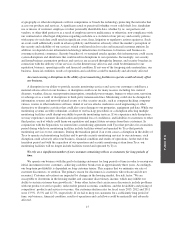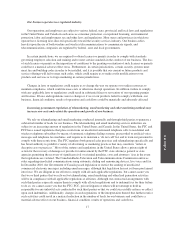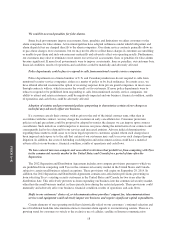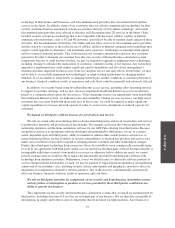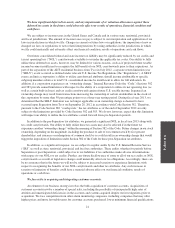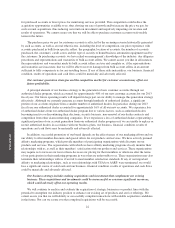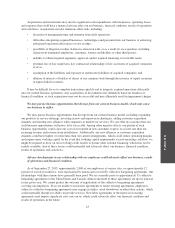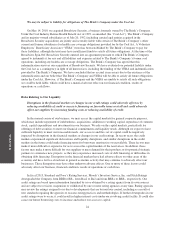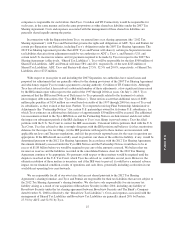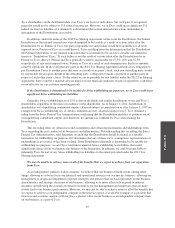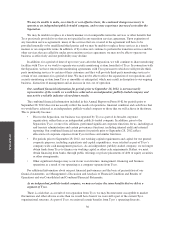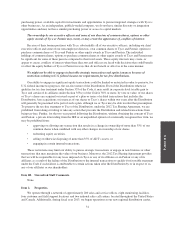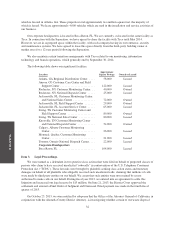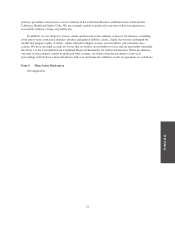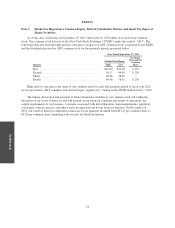ADT 2013 Annual Report Download - page 88
Download and view the complete annual report
Please find page 88 of the 2013 ADT annual report below. You can navigate through the pages in the report by either clicking on the pages listed below, or by using the keyword search tool below to find specific information within the annual report.
FORM 10-K
We may be subject to liability for obligations of The Brink’s Company under the Coal Act.
On May 14, 2010, we acquired Broadview Security, a business formerly owned by The Brink’s Company.
Under the Coal Industry Retiree Health Benefit Act of 1992, as amended (the “Coal Act”), The Brink’s Company
and its majority-owned subsidiaries as of July 20, 1992 (including certain legal entities acquired in the
Broadview Security acquisition) are jointly and severally liable with certain of The Brink’s Company’s other
current and former subsidiaries for health care coverage obligations provided for by the Coal Act. A Voluntary
Employees’ Beneficiary Associate (“VEBA”) trust has been established by The Brink’s Company to pay for
these liabilities, although the trust may have insufficient funds to satisfy all future obligations. At the time of the
Broadview Spin-Off, Broadview Security entered into an agreement pursuant to which The Brink’s Company
agreed to indemnify it for any and all liabilities and expenses related to The Brink’s Company’s former coal
operations, including any health care coverage obligations. The Brink’s Company has agreed that this
indemnification survives our acquisition of Broadview Security. We have evaluated our potential liability under
the Coal Act as a contingency in light of all known facts, including the funding of the VEBA and indemnification
provided by The Brink’s Company. We have concluded that no accrual is necessary due to the existence of the
indemnification and our belief that The Brink’s Company and VEBA will be able to satisfy all future obligations
under the Coal Act. However, if The Brink’s Company and the VEBA are unable to satisfy all such obligations,
we could be held liable, which could have a material adverse effect on our financial condition, results of
operations or cash flows.
Risks Relating to Our Liquidity
Disruptions in the financial markets or changes in our credit ratings could adversely affect us by
reducing availability of credit or access to financing on favorable terms or at all and could adversely
affect our suppliers by increasing funding costs or reducing availability of credit.
In the normal course of our business, we may access the capital markets for general corporate purposes,
which may include repayment of indebtedness, acquisitions, additions to working capital, repurchase of common
stock, capital expenditures and investments in our business. We rely on the capital markets, particularly for
offerings of debt securities to meet our financial commitments and liquidity needs. Although we expect to have
sufficient liquidity to meet our foreseeable needs, our access to and the cost of capital could be negatively
impacted by disruptions in the financial markets or changes in our credit ratings. In recent years, the credit
markets experienced significant dislocations and liquidity disruptions, and similar disruptions in the credit
markets in the future could make financing terms for borrowers unattractive or unavailable. These factors may
make it more difficult or expensive for us to access the capital markets if the need arises. In addition, these
factors may make it more difficult for our suppliers to meet demand for their products or for potential strategic
partners to commence new projects, as they may experience increased costs of debt financing or difficulties in
obtaining debt financing. Disruptions in the financial markets have had adverse effects on other areas of the
economy and have led to a slowdown in general economic activity that may continue to adversely affect our
businesses. These disruptions may have other unknown adverse effects. One or more of these factors could
adversely affect our business, financial condition, results of operations or cash flows.
In fiscal 2013, Standard and Poor’s Rating Services, Moody’s Investors Service, Inc. and Fitch Ratings
downgraded the Company from BBB to BB-, from Baa2 to Ba2 and from BBB+ to BBB-, respectively. Our
credit ratings are based upon information furnished by us or obtained by a rating agency from its own sources
and are subject to revision, suspension or withdrawal by one or more rating agencies at any time. Rating agencies
may review the ratings assigned to us due to developments that are beyond our control, including as a result of
new standards requiring the agencies to reassess rating practices and methodologies. If further downgrades in our
credit ratings were to occur, it could result in higher interest costs under our revolving credit facility. It could also
cause our future borrowing costs to increase and reduce our access to capital.
24



